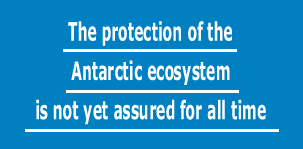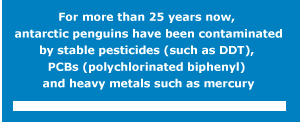|
  
|
 |



|
 Antarctic
Polar Regions | Protecting Antarctica Antarctic
Polar Regions | Protecting Antarctica
Is the 6th continent under threat ?
Is the 6th continent under threat today? The first question to be asked when thinking about the future of the Antarctic ecosystem is whether the Madrid Protocol constitutes a valid guarantee against possible abuse. Without wishing to cast a shadow over the success achieved by the consultative parties in 1991 in the Spanish capital, it should nevertheless be pointed out that the protection of the Antarctic ecosystem has not yet been achieved on a permanent basis. Because, for it to come into force, the Protocol has to be ratified by all of the consultative parties: and as yet, even though most countries have ratified it, four countries, including three giants, the United States, Japan and Russia (the fourth country is Finland), have not yet taken the step - and it is now eight years since the wording was signed in Madrid.
The USA puts forward the argument that it would prefer to wait for all of the American application laws relating to the provisions in the Protocol to be voted on before ratifying it; as for Japan, all it wants to do is protect its whaling. In addition, coming into force does not necessarily mean actually being applied on the ground: because, for all of the wording to be put into a legal context, all of the countries involved have to adopt the application laws relating to the Protocol.
A second important question concerns the effect on human activities in Antarctica. The non-government organisations associated with defending the environment have long emphasised on the ecological effects of scientific activities; the photos these organisations have published show all kinds of waste (domestic rubbish, old plane carcasses, empty barrels, piles of scrap metal, disused machines, crumpled sheet metal, food cans, the remains of wooden frames, etc.) sometimes strewn around in the immediate vicinity of the research stations, causing damage where it has been left. The problem has been raised by SCAR which as early as 1985, recognised that the sites for the bases had been chosen for logistical criteria, without any thought as to the possible effects on the environment).
In its report published on the matter ("The Impact of man on the environment in the Antarctic"), SCAR stated that the most serious problem was disposing of the waste. The report made a distinction between solid waste, domestic waste and human waste; according to the official document, the first two are having no significant organic effect (apart from the particles of plastic being found more frequently in the stomachs of sea birds) because they can either be removed or burnt in an incinerator with controlled emissions. By contrast, the report goes on to say that human waste would have to be the subject of greater attention from the people responsible for the stations, because while some human waste can be disposed of in the sea after being treated, radioactive waste, as well as any waste containing heavy metals or long-lasting organic compounds, have to be removed away from the zone covered by the Treaty, i.e. sent back to the countries concerned.
As environmental NGOs are now permitted to attend the consultative meetings of the countries of the Treaty of Washington as observers, they have put forward a series of recommendations dealing with the disposal and recycling of waste.
This problem is being seriously debated within the (Antarctic Treaty Consultative Meeting, consultative meetings of the Antarctica Treaty) as indicated by the final report of the 19th meeting held in Seoul between 8th and 19th May 1995; this document states that resolution n° 5 encourages member states to resort to inspection lists specially developed when the measures relating to protecting the environment have to be checked. These lists - which nevertheless occupy 10 pages of the report - are divided into 4 groups and concern existing installations, ships operating in the sector covered by the Treaty, abandoned bases and places where waste is stored. A year later, at the 20th meeting of the ATCM (Utrecht, 29th April -10th May 1996), the very notion of "damage" caused to the environment was, once again, debated at length.
Of course, all that constitutes a step forward in terms of the attention paid to this problem. But it is the effective application of these texts on the ground that still has to be strengthened. Because, even though a good number of base managers have started to clean up around their bases, even though some countries are more vigilant than others in disposing of every scrap of waste by taking everything back home, and even though the Americans added an amount of 10 million dollars to their 1990 budget for their Antarctic bases (thus taking the envelope to 152 million dollars) with the sole aim of allocating this money to the protection of the environment, the fact is that with the current state of affairs, it is impossible for the inspectors to conduct a systematic check of the provisions made to dispose of waste and hence to determine the extent to which they run the risk of disturbing the environment. When you realise that the most modern Antarctic stations are equipped with every conceivable comfort - bowling, sauna, aerobics classes, library, cinema, sports hall, cookery courses - and that in the summer, for example, more than a thousand people live at the McMurdo base, one can only raise doubts about the effective disposal of waste even though, in everyone's opinion, this pollution remains confined to the locations where the bases have been built and is only measured in terms of ethics and aesthetics, rather than real damage caused to the environment.
 A more worrying form of pollution by contrast, concerns pollutants arriving in the Antarctic carried by the atmosphere, currents or marine animals. We know that for more than 25 years now, Antarctic penguins have been contaminated by stable pesticides (such as DDT), PCBs (polychlorinated biphenyl) and heavy metals such as mercury. These residues come mainly from human activity in third-world countries, where they are used massively and preventively, while some of the extremely stable residues, such as organochlorine pesticides have been banned in the northern countries that produce them since the 1970s. They finally reach the ocean, where they follow the currents and ultimately reach the southern waters. As a result, the team led by Claude Joiris (Laboratory for Ecotoxicology and Polar Ecology, VUB, Brussels) has detected residues of DDT in Antarctica, while in Europe, on account of the slow and poorly known organic process related to this residue, they have all been converted into DDE, a more stable and more toxic metabolite than DDT itself. The presence of DDT that has still not be converted therefore represents proof of recent contamination. A more worrying form of pollution by contrast, concerns pollutants arriving in the Antarctic carried by the atmosphere, currents or marine animals. We know that for more than 25 years now, Antarctic penguins have been contaminated by stable pesticides (such as DDT), PCBs (polychlorinated biphenyl) and heavy metals such as mercury. These residues come mainly from human activity in third-world countries, where they are used massively and preventively, while some of the extremely stable residues, such as organochlorine pesticides have been banned in the northern countries that produce them since the 1970s. They finally reach the ocean, where they follow the currents and ultimately reach the southern waters. As a result, the team led by Claude Joiris (Laboratory for Ecotoxicology and Polar Ecology, VUB, Brussels) has detected residues of DDT in Antarctica, while in Europe, on account of the slow and poorly known organic process related to this residue, they have all been converted into DDE, a more stable and more toxic metabolite than DDT itself. The presence of DDT that has still not be converted therefore represents proof of recent contamination.
A similar situation exists with regard to heavy metals, such as mercury. Aiming to research environments not contaminated by man so that they could determine the natural level of mercury in nature, the same researchers from the VUB went to conduct their observations in the polar regions; the results of these programmes illustrate that contrary to the low levels encountered in arctic areas, the levels recorded in the Antarctic are much higher and are constantly rising.
|


 A more worrying form of pollution by contrast, concerns pollutants arriving in the Antarctic carried by the atmosphere, currents or marine animals. We know that for more than 25 years now, Antarctic penguins have been contaminated by stable pesticides (such as DDT), PCBs (polychlorinated biphenyl) and heavy metals such as mercury. These residues come mainly from human activity in third-world countries, where they are used massively and preventively, while some of the extremely stable residues, such as organochlorine pesticides have been banned in the northern countries that produce them since the 1970s. They finally reach the ocean, where they follow the currents and ultimately reach the southern waters. As a result, the team led by Claude Joiris (Laboratory for Ecotoxicology and Polar Ecology, VUB, Brussels) has detected residues of DDT in Antarctica, while in Europe, on account of the slow and poorly known organic process related to this residue, they have all been converted into DDE, a more stable and more toxic metabolite than DDT itself. The presence of DDT that has still not be converted therefore represents proof of recent contamination.
A more worrying form of pollution by contrast, concerns pollutants arriving in the Antarctic carried by the atmosphere, currents or marine animals. We know that for more than 25 years now, Antarctic penguins have been contaminated by stable pesticides (such as DDT), PCBs (polychlorinated biphenyl) and heavy metals such as mercury. These residues come mainly from human activity in third-world countries, where they are used massively and preventively, while some of the extremely stable residues, such as organochlorine pesticides have been banned in the northern countries that produce them since the 1970s. They finally reach the ocean, where they follow the currents and ultimately reach the southern waters. As a result, the team led by Claude Joiris (Laboratory for Ecotoxicology and Polar Ecology, VUB, Brussels) has detected residues of DDT in Antarctica, while in Europe, on account of the slow and poorly known organic process related to this residue, they have all been converted into DDE, a more stable and more toxic metabolite than DDT itself. The presence of DDT that has still not be converted therefore represents proof of recent contamination.